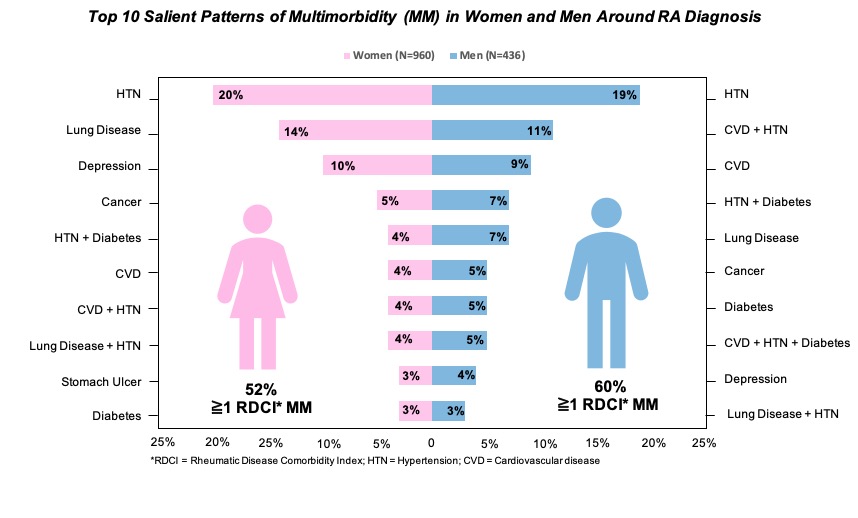Session Information
Session Type: Poster Session D
Session Time: 8:30AM-10:30AM
Background/Purpose: Chronic disease multimorbidity (MM) is prevalent in RA. As MM can vary in complexity and different combinations of chronic conditions may have different physical and psychological impacts on patients, there is an increasing need to identify which specific conditions may cluster around the time of RA onset. The objective of the present study was to identify the top 10 most prevalent MC patterns in women and men around RA diagnosis and estimate their associations with disability over the first year of follow up, in a large real-world incident RA cohort.
Methods: Data were from early RA patients (< 1-year of symptoms; 88% meeting RA classification criteria) diagnosed and treated in rheumatology clinics across Canada enrolled in CATCH (Canadian Early Arthritis Cohort) from Jan 2007 through March 2020. Participants were included in the present study if they completed the Rheumatic Disease Comorbidity Index (RDCI) at baseline and repeat assessments of disease activity (DAS28) and disability (MHAQ) every 3- months over 1 year follow up. The RDCI is a validated weighted comorbidity index (range 0-9) assessing the presence of 11 conditions selected based on associations with RD health outcomes (lung disease, CVD (MI, stroke, and other CV), HTN, fracture, depression, diabetes, cancer, ulcer or stomach problem). We identified the top 10 most prevalent MM patterns in women and men by first coding the presence/ absence of each condition for each participant and then ranking the prevalence of all possible reported combinations by sex. We estimated sex-stratified longitudinal associations between prevalent MM patterns and repeated measures of disability in the first year follow up with generalized estimating equations (GEE), adjusted for age, education, symptom duration, smoking, obesity and time-varying measures of DAS28 disease activity.
Results: The sample included 2,576 ERA patients, 1843 (72%) were female, with a mean(sd) age of 56 (15) years and 6 (3) months of symptoms. At baseline 2,449 (95%) were treated with csDMARDs (mostly methotrexate (74%)) and 40 (2%) with a biologic. More than half of patients (54%) reported >=1 MM. Prevalence, patterns and complexity of MM differed by sex. HTN, lung disease and depression were the most prevalent MM patterns reported in women and HTN, CVD, and CVD+HTN were the most prevalent patterns reported in men (Figure). More complex MM patterns involving multiple conditions were more prevalent in men (26%) than in women (12%) (Figure). In multivariable GEE models, depression (beta: 0.14, 95% CI: 0.04, 0.24) in women, and lung disease + HTN (beta: 0.22, 95% CI: 0.03, 0.42) in men, were significantly associated with higher disability over time.
Conclusion: Results from this large real-world incident cohort study suggest that multimorbidity is common around RA diagnosis and differs between men and women. MM patterns significantly associated with increased disability over time included depression in women, and lung disease + HTN in men. Results suggest potential shared risk factors and pathways between identified MM patterns and highlight the need to screen for and treat MM conditions, particularly those which increase disability.
To cite this abstract in AMA style:
Schieir O, Bartlett S, Valois M, Bessette L, Boire G, Hazlewood G, Keystone E, Pope J, Thorne C, Tin D, Bykerk V. Sex-Stratified Patterns of Multimorbidity at RA Onset and Associated Longitudinal Impacts on Disability Over the First Year Follow Up: Results from the Canadian Early Arthritis Cohort (CATCH) [abstract]. Arthritis Rheumatol. 2021; 73 (suppl 9). https://acrabstracts.org/abstract/sex-stratified-patterns-of-multimorbidity-at-ra-onset-and-associated-longitudinal-impacts-on-disability-over-the-first-year-follow-up-results-from-the-canadian-early-arthritis-cohort-catch/. Accessed .« Back to ACR Convergence 2021
ACR Meeting Abstracts - https://acrabstracts.org/abstract/sex-stratified-patterns-of-multimorbidity-at-ra-onset-and-associated-longitudinal-impacts-on-disability-over-the-first-year-follow-up-results-from-the-canadian-early-arthritis-cohort-catch/

